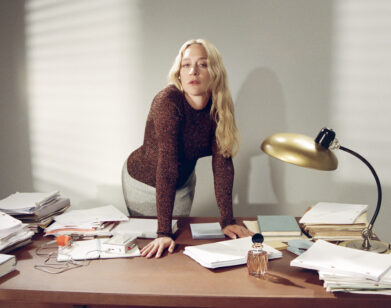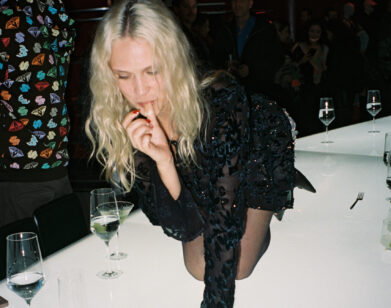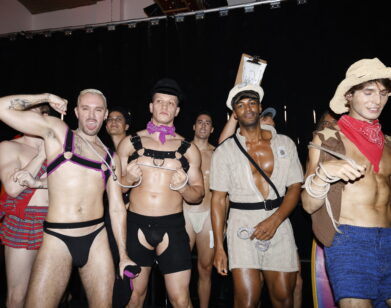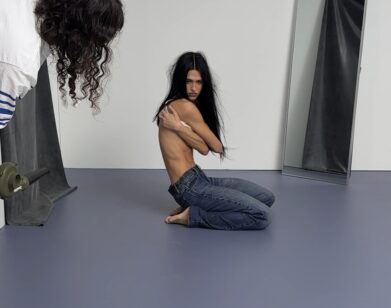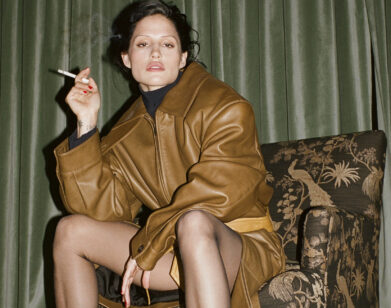Erykah Badu on Pyer Moss’s Honest Activism
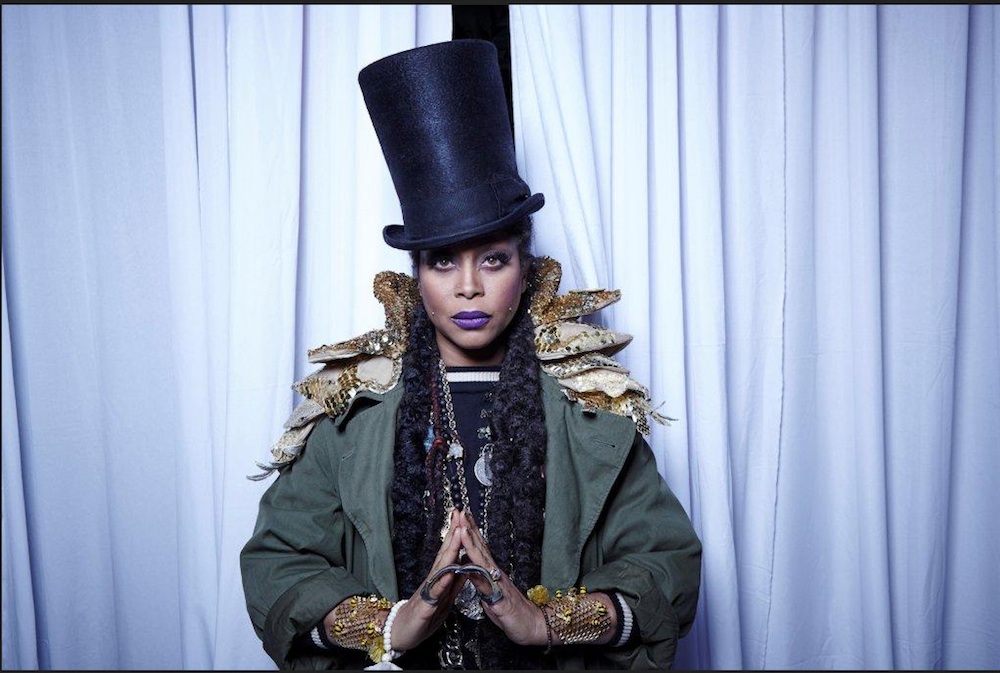
ABOVE: ERYKAH BADU. PHOTO COURTESY OF BET.
When it debuted in 1961, Frantz Fanon’s The Wretched of the Earth was censored by the French government. Borne of Fanon’s observations of the French presence in Algeria, in The Wretched of the Earth, the Martiniquais philosopher describes the psychological effects of systematic oppression on a marginalized population. “Because it is a systematized negation of the other, a frenzied determination to deny the other any attribute of humanity, colonialism forces the colonized to constantly ask the question: ‘Who am I in reality?'” he writes. “A constant and considerable stream of mental symptoms are direct sequels of this oppression.” He attributes the proliferation of psychiatric disorders he witnesses—insomnia, anxiety, depression, paranoia—to the French occupation, describing cases among both the European officers and the Algerian citizens. It’s this thought that we come back to as we speak with Erykah Badu about her upcoming collaboration with Pyer Moss designer Kerby Jean-Raymond for his Fall/Winter 2016 presentation.
Jean-Raymond’s work stands out in the fashion world for its philosophical and political underpinnings. Last season, Pyer Moss’s menswear show catapulted the designer into the spotlight for that very reason. It garnered headlines from outlets as diverse as Quartz, WWD, and Maxim for its frank conversation about police brutality and the Black Lives Matter movement. Blood spatter-patterns adorned outerwear while a video compiled from footage of the deaths of Eric Garner and Walter Scott, interviews with the families of victims of police brutality, and appearances by artists like Usher and Kehinde Wiley played in the background. It earned Jean-Raymond and his label a level of notoriety: He lost one retail account in Europe, The Fader reported, and the venue where he had scheduled the show backed out at the last minute. But it was also a rare plunge into social issues in an industry that’s overwhelmingly white (the New York Times reported in 2015 that black designers composed approximately 2.7 percent of labels showing at New York Fashion Week) and resistant to political engagement.
While Jean-Raymond’s activist convictions attracted Badu to the collaboration—she’ll be styling his upcoming runway show—she was quick to dismiss suspicions that his next show will be similarly cued to the Black Lives Matter movement. “It still deals with human issues,” she explains—the theme is “Double Bind.” She adds, “It deals with conflict between two differentiating ideas; it likens to paranoia and schizophrenia or depression.” It’s at this point that we come back to Fanon: “That is really the root of why there is racism or privilege or prejudice,” Badu says, seeming to echo the francophone philosopher, “because we are pretty much a sick society through habit.”
“The voice of this generation feels depressed,” she continues. “We’re all feeling some sort of hole inside of us, but we don’t know exactly how to ask for help or even help ourselves.”
A Texas native, Badu made a name for herself first in music, though she’s as much of a style icon as a musical one, with a well-documented penchant for good headwear. Over the past six months, she’s branched out even further, first releasing a mixtape entitled But You Caint Use My Phone, featuring a sublime cover of Drake’s “Hotline Bling,” and then appearing in the Sundance indie The Land. We called her at home in Dallas just a few days before the Pyer Moss show to discuss her foray into styling and the alignment of fashion, music, and activism.
KATHERINE CUSUMANO: To start, I wanted to ask how you got involved working on this show.
ERYKAH BADU: A mutual friend, Jason, usually pulls clothes for me when I’m doing a string of interviews or TV. I saw some of Pyer Moss’s pieces a couple of seasons ago and just kind of fell in love, and I stole them—I took them home with me. I loved them so much. Jason was calling me and telling me, I think you need to give those pieces back. I said, “Okay, I’ll make sure that I do it.” Then Jason called me another time and instead of saying he needed the piece back, he said, “I spoke to Kerby about those pieces and he actually has been wanting you to work with him on his show.” That’s pretty much how the relationship started. He had wanted to work with me for a few years, and I coveted his things. Sympathetic vibration is how we met—two like-weighted objects vibrate toward each other. I think that’s what happened.
CUSUMANO: Did you get to keep those pieces?
BADU: I still have them. [laughs] So what’s interesting about the clothes I like—they’re menswear. Even with Givenchy or Tom Ford, I prefer the men’s line. I like cuts and the fits and the silhouettes and the way that they layer. My style is a little masculine, and what I loved about Pyer Moss was how well he can make a blazer, the looseness of those pants, or color palette that he chooses from season to season.
CUSUMANO: How did being a fan of his work translate to styling it?
BADU: We have the same eye, the same understanding for what he wanted to do. My job is basically to help him fulfill his vision, and I think I really can do that because I have a good understanding of his silhouettes and his reasoning behind what he does. The platform he stands on is very similar to mine as an artist. He’s very honest and very brave. Last season’s show, he incorporated Black Lives Matter into his theme, in an industry where that could suffocate him or typecast him as a black designer or a socio-political activist or something that you wouldn’t want to carry a label with. But he was so passionate about it as a man, as a human, that he used his platform to express his feelings and to have that conversation. It was risky, because that’s one thing that you don’t want to do—to be an outsider, especially in a predominantly white world. The industry is white and we’re outsiders to a certain extent—no matter what we believe about ourselves, what the powers that be believe will affect us. That’s what I’ve seen from the outside. I thought it was extremely brave, since that is not who he is as a human being. He’s not an activist. He’s an artist. So I felt that it was supremely brave and honest of him to want to have that conversation at the risk of being typecast.
CUSUMANO: So being aware of how homogeneous fashion can be, was that a concern for you?
BADU: No, no, because I don’t know the rules. I’ve heard that they exist, but I don’t know them, and it keeps me safe. I guess they call me a rule-breaker; I don’t know I’m breaking them. I’m just being who I am and expressing myself as everyone else does.
CUSUMANO: Fashion is not as often considered as explicitly in relation to activism as, for example, music—and maybe that is because designers feel that they are at risk of being typecast or pigeonholed as activist-designers. How do you think that fashion can work as a medium for activism or for political commentary?
BADU: When it comes to fashion or any high art, you have to have a combination of delicacy, along with taste. I think the best way to describe that is to be honest and not contrived—not to use activism or some political agenda to sell your art, but because it makes sense. That’s when people believe it. It’s kind of like music—I like all kinds of music, as a human being, as Erykah. It doesn’t matter what kind it is, I just have to believe it. I have to believe the painter or the artist or the singer, and I think we resonate with that as human beings. We feel one another. We know when something is not genuine—most of us, anyway.
CUSUMANO: How does that translate visually in the show?
BADU: Through the beauty of technology, there are visuals and music. Because “Double Bind” is the theme, whatever kind of music he chooses will be a contrast to whatever we’re seeing. There are so many ways it can be expressed. Right now, for example, I’m working in Dallas and he’s in New York. We decided to separate in order to fulfill this thing. Double bind: I’m in one area doing something; he’s in another. We have two different understandings of the same kind of thing, and when that comes together visually, I think that everyone will feel it. I don’t think it’s something that can really be described, but you’ll be able to feel that. Next week, we will work together the whole week to start to actually realize the vision.
CUSUMANO: You released a mix tape in December; you appeared in a film, The Land, which premiered at Sundance; and now you are styling this show. So how do all of those different pieces fit together?
BADU: I don’t know—I just focus on what I’m working on and only that. I’m able to somehow give my full attention to my children while I’m doing all of that. I don’t waste a lot of time procrastinating anymore. I’d rather just get to it, because I’ve experienced that sometimes, prolonged art, you end up polishing and polishing shit. It’s either going to be shit, or it’s going to be polished shit. When I was working on the mixtape, that’s all I did for those two months. I have to focus on only that thing. I don’t feel like it’s a race. It’s super therapeutic for me and it really gives the art or the piece the respect that it deserves.
CUSUMANO: The mixtape is a sort of sonic collage—it draws from all these different sources, and I’m wondering if you see any parallels from the way that you draw inspiration for your music and for fashion.
BADU: It’s similar. I don’t know what ingredient gives it its motif, but it comes from the same kind of honest process—going into something not really knowing what you’re going to do or what’s going to be created. I imagine that when I am creating a song or a project or an album or putting some clothing together or cooking a meal, whatever it is, I don’t really have a recipe. The fun part is to throw that big piece of clay in the middle of the table as hard as I can, and whatever shape it takes, that’s what shape it takes, and then I start to carve away. I don’t want to think too much about how I’m carving and what I’m carving—you are just carving away the excess clay and there’s a piece underneath there. And it’s kind of like getting out of the way. Maybe that’s what the commonality is: It’s getting out of the way so that the art can speak.
CUSUMANO: Not knowing what’s going to be created—is that something that draws you to a new project?
BADU: I think that’s just the process. It’s always like that. Even if the project requires you to have all the ducks in a line, I can’t do that. I don’t create way. What draws me to a project is how sympathetic I am toward it, so that I can relax into it and give up myself. That’s what attracts me.
CUSUMANO: What is your first memory of fashion?
BADU: It’s going to be musical. There are three things that come to mind: seeing Parliament-Funkadelic perform as a child. It was shocking and inspiring and stimulating to see all of these different characters and ideas be one living, breathing organism on the stage. That is how funk looks. Whenever I think about funk music, it has a look—and that’s how it sounds. Another experience would be with David Bowie. There was this one particular picture where he has on this maybe rhinestone or sequined suit, but the pants are in some kind of obscure shape. It looks like a sculpture. When I saw that, I was a teenager, and I said, “That’s functional art.” That’s art that you wear and that moves when you move and walks when you walk. That’s when I realized this is what art is supposed to do—it’s supposed to create dialogue. Everybody’s not supposed to like it, though. You hope enough people dislike it so that they can be inspired to create their own shit, and that’s what’s important about David Bowie or Grace Jones and George Clinton.
CUSUMANO: What’s coming up next for you? You’ve done a little bit of everything over the past six months, so where do you go from here?
BADU: Oh, I just keep going. When the water’s too still, I start splashing around and things jump out of the water.
PYER MOSS’S F/W 2016 COLLECTION WILL SHOW THIS SATURDAY, FEBRUARY 13, AS PART OF NYFW.

